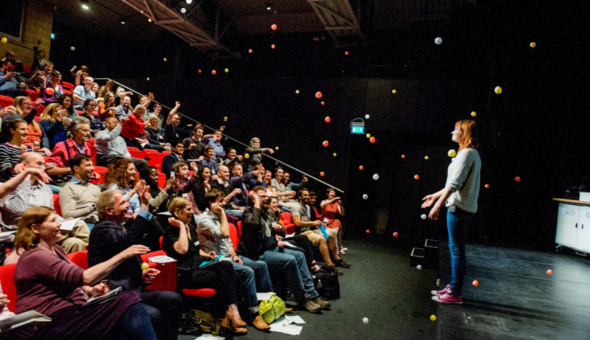Many of us are now looking for ways to engage with public groups in the absence of face to face events. Online platforms can provide a great opportunity to reach people where they already are such as Facebook, Reddit, Twitter or custom-built events on Zoom or Microsoft Teams. The short guide aims to pull together some top tips for digital engagement.
It’s worth remembering that not everyone has access to a high-speed internet connection or a computer and may not be used to these digital platforms. It can be worth thinking about what non-digital methods there are for engaging with public groups e.g. sending out a newsletter or crafting kits. This can be challenging, particularly while obeying social distancing rules, but we shouldn’t assume that everyone can or wants to engage online.
Whether you're creating videos for YouTube or hosting workshops through Microsoft Teams there are some general principles to engaging online that will help your events run smoothly. Below we've collected a list of top tips from across the public engagement and science communication sector to help you successfully engage online.
Audio and Video
- Audio: If possible, use a headset for audio. If not possible, try to use headphones while using the built-in microphone on your computer/phone, as this will stop any feedback or echo from occurring. If you do not have a headset or headphones remember to mute your microphone when you aren’t speaking.
- Video: While audio quality is generally more important than video it still helps to have high quality video, particularly if you are presenting. You can download apps that allow your smartphone to function as a webcam - try these out and see what option gives you the best video.
- Camera position: Ideally this should be as close to eye level as possible. It creates the illusion of eye contact with the other people in the call. If using a laptop, place something underneath to raise the camera, to avoid the ‘looking down on’ the camera shot.
- Background: Consider what is behind you in shot. Try to find something neutral that won’t be distracting to other people viewing your camera. Microsoft Teams and some other platforms have a blur function to remove your background or replace it completely with a stock image.
- Lighting: Light your face well—you can’t have too much light for most cameras. Avoid having windows behind you, as the camera will struggle, and show your face in darkness.
Presenting
- Accessibility: Take account of your audience's needs and how you will meet them. Some platforms have live subtitling or an option for participants to ‘raise their hand’ if they need help. You could also use cue cards to help less confident members get involved. Make sure this is communicated ahead of time so your audience know how they can engage.
- Body Language: Sit upright, smile and act as if you are speaking to someone in person. Remember that people can still see you even when you aren’t speaking so don’t do anything to distract from the other speakers.
- Duration: Consider how long people will be able to commit to an online event – it takes a lot of concentration to engage online. For longer events remember to schedule breaks where people can use the toilet, get a drink or stretch their legs.
- Variety: Attention spans can be very short online so use a variety of techniques to keep your audience's attention. Have a number of different speakers, play videos, split the audience into breakout rooms to discuss a topic, have a short quiz, take questions. All of these techniques and more can be used to keep your audience engaged.
- Audience participation: The sooner you can get people talking the more likely they are to contribute to the rest of the session. Ask your audience to introduce themselves at the beginning or arrange smaller break out groups to give people the chance to talk if you want them to actively contribute.
- Questions: Let your audience know how you want to receive questions. You might want them to leave questions in the chat window or ask for questions verbally at the end of your talk. Make sure your audience knows what method you’ll be using.
Support
- Technical support: Having a team member on hand who can help audience members with any technical issues can save you a lot of time and help the event run more smoothly for participants. This is especially useful if you are asking your participants to use break out rooms, edit documents or use any other more advanced functionality of your platform.
- Event support: Having a team member on hand to monitor your audience can be very helpful, particularly for larger events. Consider what role you need this team member to be in. Do you want them to be collecting questions for Q&A at the end, answering questions in the chat, moderating comments/questions or being ready to take over in case you have any technical problems.
- Host: If you are running an event with multiple speakers or sections then a host is vital. The host will need to welcome everyone to the meeting, set out housekeeping which includes online etiquette such as muting microphones when not speaking, and keep speakers to time.
Get involved
The Public Engagement Unit have been working to create digital engagement opportunities. If you would like to take part in one of our Research at Lunchtime talks on Facebook Live, Ask Me Anything (AMA) on Reddit or the online Minerva Series then please get in touch.
The University of Bath Audio Visual team have been invaluable in helping us set up online events and get the most out of video calls and platforms like Microsoft Teams. Much of the advice in this post comes from their expert guidance. If you need technical support or advice with online engagement you can contact the AV team here.
More information
- National Coordinating Centre for Public Engagement guide to engaging online
- Digital Engagement in culture, heritage and the arts
- University of Glasgow guide to creating videos
- How to make pro videos with your phone during a pandemic
Rob Cooper is Public Engagement Officer at the University of Bath.
Respond



